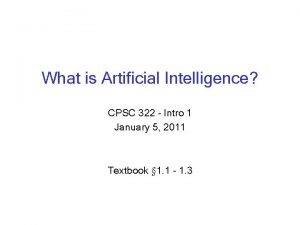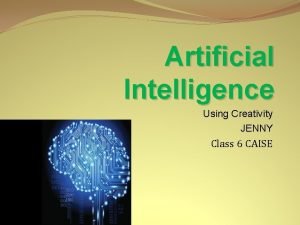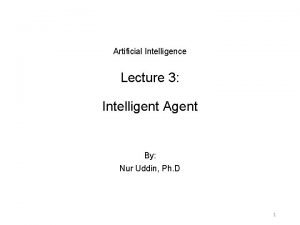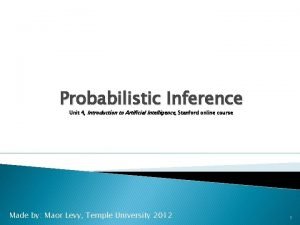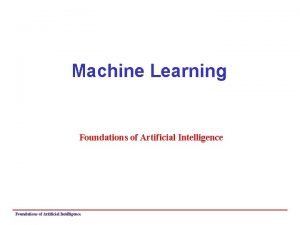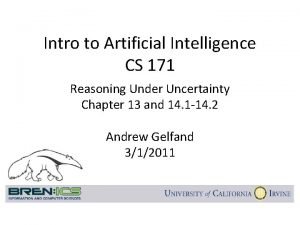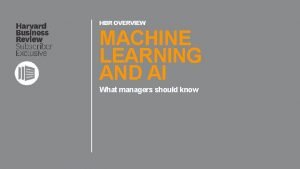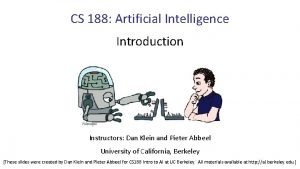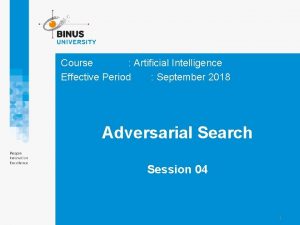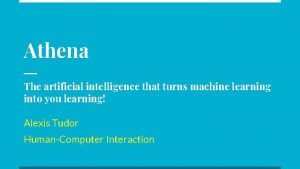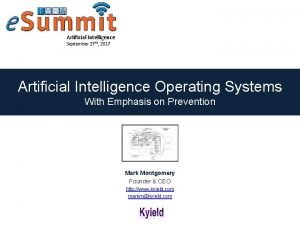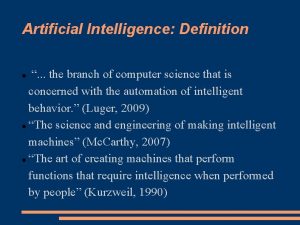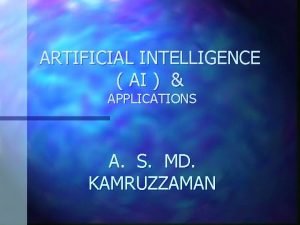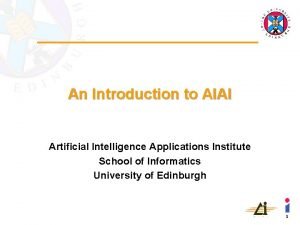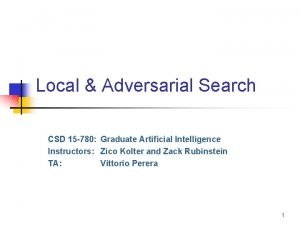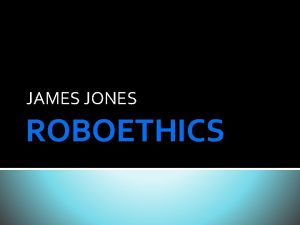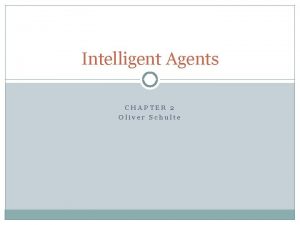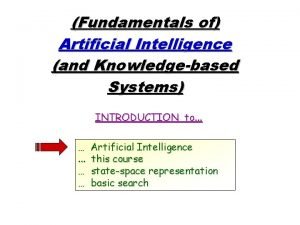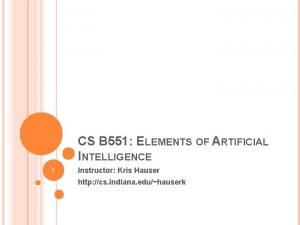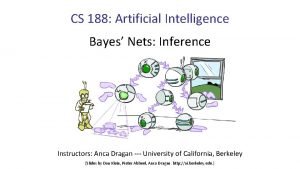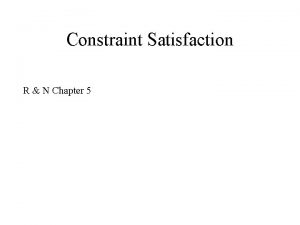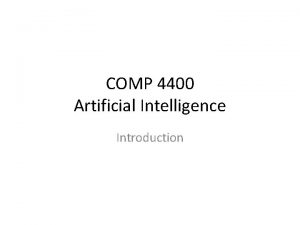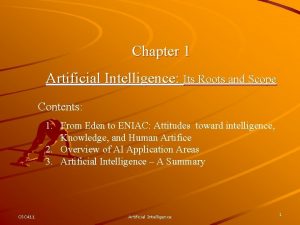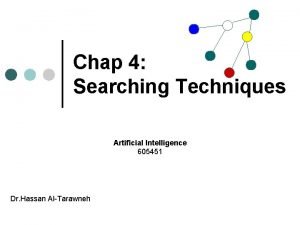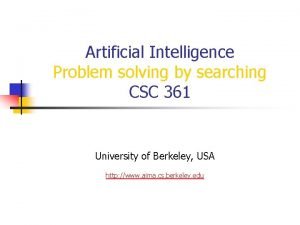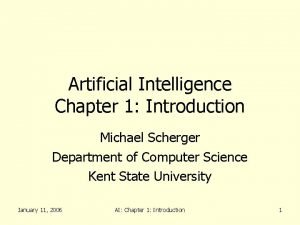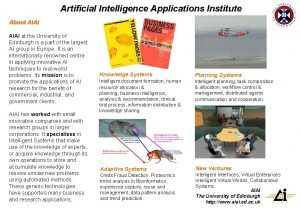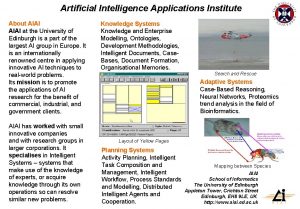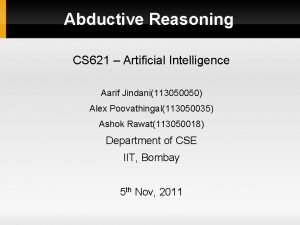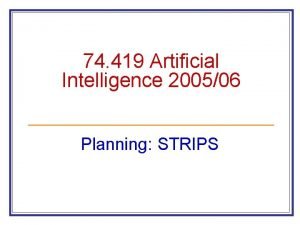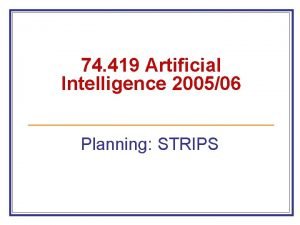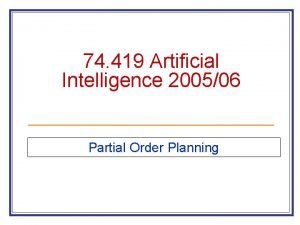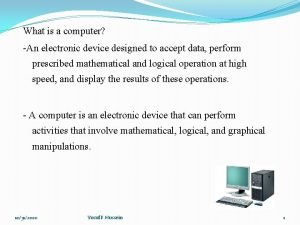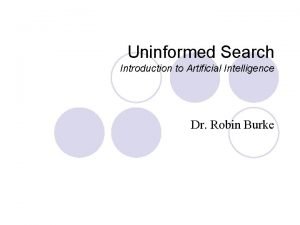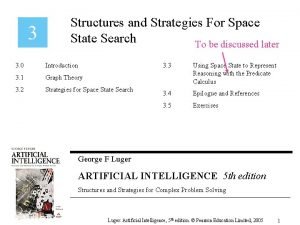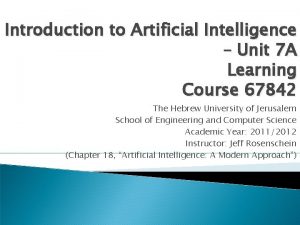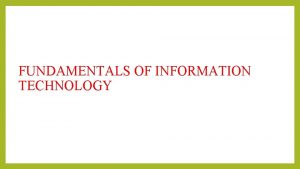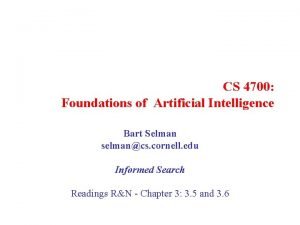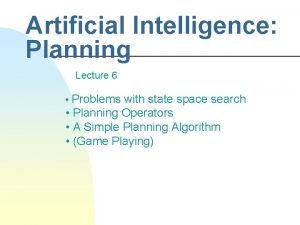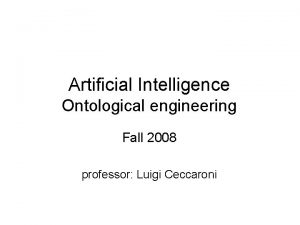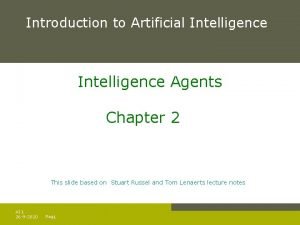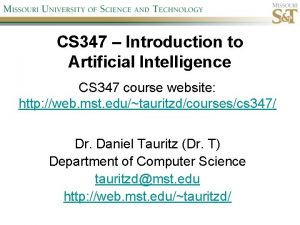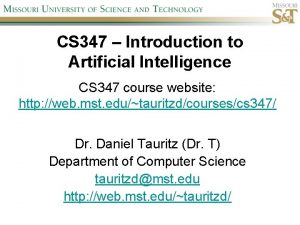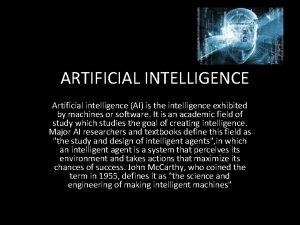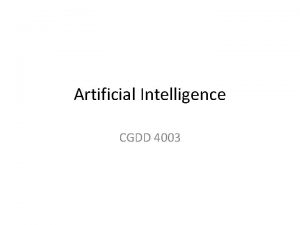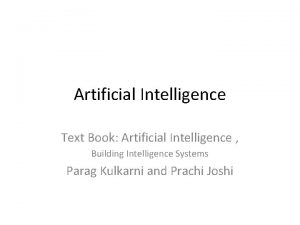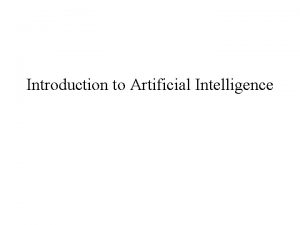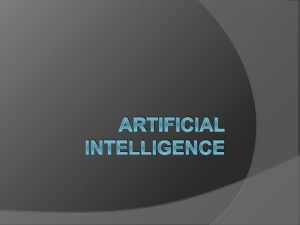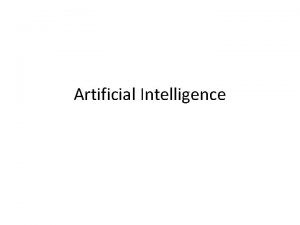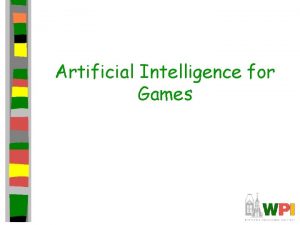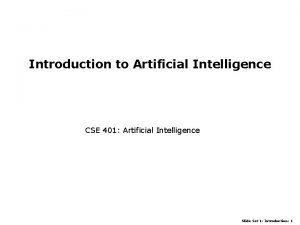CS 347 Introduction to Artificial Intelligence CS 347


















































































- Slides: 82

CS 347 – Introduction to Artificial Intelligence CS 347 course website: http: //web. mst. edu/~tauritzd/courses/cs 347/ Dr. Daniel Tauritz (Dr. T) Department of Computer Science tauritzd@mst. edu http: //web. mst. edu/~tauritzd/

What is AI? Systems that… –act like humans (Turing Test) –think like humans –think rationally –act rationally Play Ultimatum Game

Rational Agents • • • Environment Sensors (percepts) Actuators (actions) Agent Function Agent Program Performance Measures

Rational Behavior Depends on: • Agent’s performance measure • Agent’s prior knowledge • Possible percepts and actions • Agent’s percept sequence

Rational Agent Definition “For each possible percept sequence, a rational agent selects an action that is expected to maximize its performance measure, given the evidence provided by the percept sequence and any prior knowledge the agent has. ”

Task Environments PEAS description & properties: –Fully/Partially Observable –Deterministic, Stochastic, Strategic –Episodic, Sequential –Static, Dynamic, Semi-dynamic –Discrete, Continuous –Single agent, Multiagent –Competitive, Cooperative

Problem-solving agents A definition: Problem-solving agents are goal based agents that decide what to do based on an action sequence leading to a goal state.

Problem-solving steps • Problem-formulation (actions & states) • Goal-formulation (states) • Search (action sequences) • Execute solution

Well-defined problems • • • Initial state Action set Transition model: RESULT(s, a) Goal test Path cost Solution / optimal solution

Example problems • • Vacuum world Tic-tac-toe 8 -puzzle 8 -queens problem

Search trees • Root corresponds with initial state • Vacuum state space vs. search tree • Search algorithms iterate through goal testing and expanding a state until goal found • Order of state expansion is critical!

Search node datastructure • • n. STATE n. PARENT-NODE n. ACTION n. PATH-COST States are NOT search nodes!

Frontier • Frontier = Set of leaf nodes • Implemented as a queue with ops: – EMPTY? (queue) – POP(queue) – INSERT(element, queue) • Queue types: FIFO, LIFO (stack), and priority queue

Problem-solving performance • • Completeness Optimality Time complexity Space complexity

Complexity in AI • • b – branching factor d – depth of shallowest goal node m – max path length in state space Time complexity: # generated nodes Space complexity: max # nodes stored Search cost: time + space complexity Total cost: search + path cost

Tree Search • • • Breadth First Tree Search (BFTS) Uniform Cost Tree Search (UCTS) Depth-First Tree Search (DFTS) Depth-Limited Tree Search (DLTS) Iterative-Deepening Depth-First Tree Search (ID-DFTS)

Example state space #1

Breadth First Tree Search (BFTS) • Frontier: FIFO queue • Complete: if b and d are finite • Optimal: if path-cost is non-decreasing function of depth • Time complexity: O(b^d) • Space complexity: O(b^d)

Uniform Cost Tree Search (UCTS) • Frontier: priority queue ordered by g(n)

Depth First Tree Search (DFTS) • • • Frontier: LIFO queue (a. k. a. stack) Complete: no Optimal: no Time complexity: O(bm) Space complexity: O(bm) Backtracking version of DFTS has a space complexity of: O(m)

Depth-Limited Tree Search (DLTS) • • • Frontier: LIFO queue (a. k. a. stack) Complete: not when l < d Optimal: no Time complexity: O(b^l) Space complexity: O(bl) Diameter: min # steps to get from any state to any other state

Diameter example 1

Diameter example 2

Example state space #2

Graph Search • • • Breadth First Graph Search (BFGS) Uniform Cost Graph Search (UCGS) Depth-First Graph Search (DFGS) Depth-Limited Graph Search (DLGS) Iterative-Deepening Depth-First Graph Search (ID-DFGS)

Best First Search (Be. FS) • Select node to expand based on evaluation function f(n) • Typically node with lowest f(n) selected because f(n) correlated with path-cost • Represent frontier with priority queue sorted in ascending order of f-values

Path-cost functions • g(n) = lowest path-cost from start node to node n • h(n) = estimated path-cost of cheapest path from node n to a goal node [with h(goal)=0]

Heuristics • h(n) is a heuristic function • Heuristics incorporate problemspecific knowledge • Heuristics need to be relatively efficient to compute

Important Be. FS algorithms • UCS: f(n) = g(n) • GBe. FS: f(n) = h(n) • A*S: f(n) = g(n)+h(n)

GBe. FTS • Incomplete (so also not optimal) • Worst-case time and space complexity: O(bm) • Actual complexity depends on accuracy of h(n)

A*S • f(n) = g(n) + h(n) • f(n): estimated cost of optimal solution through node n • if h(n) satisfies certain conditions, A*S is complete & optimal

Example state space # 3

Admissible heuristics • h(n) admissible if: Example: straight line distance A*TS optimal if h(n) admissible

Consistent heuristics • h(n) consistent if: Consistency implies admissibility A*GS optimal if h(n) consistent

A* search notes • • • Optimally efficient for consistent heuristics Run time is a function of the heuristic error Suboptimal variants Not strictly admissible heuristics A* Graph Search not scalable due to memory requirements

Memory-bounded heuristic search • • • Iterative Deepening A* (IDA*) Recursive Best-First Search (RBFS) IDA* and RBFS don’t use all avail. memory Memory-bounded A* (MA*) Simplified MA* (SMA*) Meta-level learning aims to minimize total problem solving cost

Heuristic Functions • • Effective branching factor Domination Composite heuristics Generating admissible heuristics from relaxed problems

Sample relaxed problem • n-puzzle legal actions: Move from A to B if horizontally or vertically adjacent and B is blank Relaxed problems: (a)Move from A to B if adjacent (b)Move from A to B if B is blank (c) Move from A to B

Generating admissible heuristics The cost of an optimal solution to a relaxed problem is an admissible heuristic for the original problem.

Adversarial Search Environments characterized by: • Competitive multi-agent • Turn-taking Simplest type: Discrete, deterministic, two-player, zero-sum games of perfect information

Search problem formulation • • • S 0: Initial state (initial board setup) Player(s): Actions(s): Result(s, a): Terminal test: game over! Utility function: associates playerdependent values with terminal states

Minimax


Depth-Limited Minimax • State Evaluation Heuristic estimates Minimax value of a node • Note that the Minimax value of a node is always calculated for the Max player, even when the Min player is at move in that node!

Iterative-Deepening Minimax • IDM(n, d) calls DLM(n, 1), DLM(n, 2), …, DLM(n, d) • Advantages: –Solution availability when time is critical –Guiding information for deeper searches

Redundant info example

Alpha-Beta Pruning • α: worst value that Max will accept at this point of the search tree • β: worst value that Min will accept at this point of the search tree • Fail-low: encountered value <= α • Fail-high: encountered value >= β • Prune if fail-low for Min-player • Prune if fail-high for Max-player

DLM w/ Alpha-Beta Pruning Time Complexity • Worst-case: O(bd) • Best-case: O(bd/2) [Knuth & Moore, 1975] • Average-case: O(b 3 d/4)

Move Ordering Heuristics • Knowledge based • Killer Move: the last move at a given depth that caused AB-pruning or had best minimax value • History Table

Example game tree

Example game tree

Search Depth Heuristics • Time based / State based • Horizon Effect: the phenomenon of deciding on a non-optimal principal variant because an ultimately unavoidable damaging move seems to be avoided by blocking it till passed the search depth • Singular Extensions / Quiescence Search

Time Per Move • • Constant Percentage of remaining time State dependent Hybrid

Quiescence Search • When search depth reached, compute quiescence state evaluation heuristic • If state quiescent, then proceed as usual; otherwise increase search depth if quiescence search depth not yet reached • Call format: QSDLM(root, depth, QSdepth), QSABDLM(root, depth, QSdepth, α, β), etc.

QS game tree Ex. 1

QS game tree Ex. 2

Forward pruning • Beam Search (n best moves) • Prob. Cut (forward pruning version of alpha-beta pruning)

Transposition Tables (1) • Hash table of previously calculated state evaluation heuristic values • Speedup is particularly huge for iterative deepening search algorithms! • Good for chess because often repeated states in same search

Transposition Tables (2) • Datastructure: Hash table indexed by position • Element: – State evaluation heuristic value – Search depth of stored value – Hash key of position (to eliminate collisions) – (optional) Best move from position

Transposition Tables (3) • Zobrist hash key – Generate 3 d-array of random 64 -bit numbers (piece type, location and color) – Start with a 64 -bit hash key initialized to 0 – Loop through current position, XOR’ing hash key with Zobrist value of each piece found (note: once a key has been found, use an incremental apporach that XOR’s the “from” location and the “to” location to move a piece)

MTD(f) MTDf(root, guess, depth) { lower = -∞; upper = ∞; do { beta=guess+(guess==lower); guess = ABMax. V(root, depth, beta-1, beta); if (guess<beta) upper=guess; else lower=guess; } while (lower < upper); return guess; } // also needs to return best move

IDMTD(f) IDMTDf(root, first_guess, depth_limit) { guess = first_guess; for (depth=1; depth ≤ depth_limit; depth++) guess = MTDf(root, guess, depth); return guess; } // actually needs to return best move


Adversarial Search in Stochastic Environments Worst Case Time Complexity: O(bmnm) with b the average branching factor, m the deepest search depth, and n the average chance branching factor

Example “chance” game tree

Expectiminimax & Pruning • Interval arithmetic • Monte Carlo simulations (for dice called a rollout)

Null Move Forward Pruning • Before regular search, perform shallower depth search (typically two ply less) with the opponent at move; if beta exceeded, then prune without performing regular search • Sacrifices optimality for great speed increase

Futility Pruning • If the current side to move is not in check, the current move about to be searched is not a capture and not a checking move, and the current positional score plus a certain margin (generally the score of a minor piece) would not improve alpha, then the current node is poor, and the last ply of searching can be aborted. • Extended Futility Pruning • Razoring

State-Space Search • • Complete-state formulation Objective function Global optima Local optima (don’t use textbook’s definition!) • Ridges, plateaus, and shoulders • Random search and local search

Steepest-Ascent Hill-Climbing • Greedy Algorithm - makes locally optimal choices Example 8 queens problem has 88≈17 M states SAHC finds global optimum for 14% of instances in on average 4 steps (3 steps when stuck) SAHC w/ up to 100 consecutive sideways moves, finds global optimum for 94% of instances in on average 21 steps (64 steps when stuck)

Stochastic Hill-Climbing • Chooses at random from among uphill moves • Probability of selection can vary with the steepness of the uphill move • On average slower convergence, but also less chance of premature convergence

More Local Search Algorithms • First-choice hill-climbing • Random-restart hill-climbing • Simulated Annealing

Population Based Local Search • • • Deterministic local beam search Stochastic local beam search Evolutionary Algorithms Particle Swarm Optimization Ant Colony Optimization

Particle Swarm Optimization • PSO is a stochastic population-based optimization technique which assigns velocities to population members encoding trial solutions • PSO update rules: PSO demo: http: //www. borgelt. net//psopt. html

Ant Colony Optimization • Population based • Pheromone trail and stigmergetic communication • Shortest path searching • Stochastic moves

Online Search • • Offline search vs. online search Interleaving computation & action Exploration problems, safely explorable Agents have access to: – ACTIONS(s) – c(s, a, s’) – GOAL-TEST(s)

Online Search Optimality • CR – Competitive Ratio • TAPC – Total Actual Path Cost • C* - Optimal Path Cost • Best case: CR = 1 • Worst case: CR = ∞

Online Search Algorithms • Online-DFS-Agent • Random Walk • Learning Real-Time A* (LRTA*)

Online Search Example Graph 1

Online Search Example Graph 2

Online Search Example Graph 3

AI courses at S&T • • CS 345 Computational Robotic Manipulation (SP 2012) CS 347 Introduction to Artificial Intelligence (SP 2012) CS 348 Evolutionary Computing (FS 2011) CS 434 Data Mining & Knowledge Discovery (FS 2011) CS 447 Advanced Topics in AI (SP 2013) CS 448 Advanced Evolutionary Computing (SP 2012) Cp. E 358 Computational Intelligence (FS 2011) Sys. Eng 378 Intro to Neural Networks & Applications
 Pxdes
Pxdes Cpsc 322: introduction to artificial intelligence
Cpsc 322: introduction to artificial intelligence Cpsc 322: introduction to artificial intelligence
Cpsc 322: introduction to artificial intelligence Mycin expert system
Mycin expert system State space search ai
State space search ai Searching for solutions in artificial intelligence
Searching for solutions in artificial intelligence 15-780 graduate artificial intelligence
15-780 graduate artificial intelligence Knowledge manipulation in artificial intelligence
Knowledge manipulation in artificial intelligence What is declarative knowledge in ai
What is declarative knowledge in ai Starts new page numbered sequentially
Starts new page numbered sequentially Artificial intelligence leadership
Artificial intelligence leadership Artificial intelligence assessment
Artificial intelligence assessment What math is used in artificial intelligence
What math is used in artificial intelligence Peas of vacuum cleaner
Peas of vacuum cleaner 15-780 graduate artificial intelligence
15-780 graduate artificial intelligence Xkcd deep learning
Xkcd deep learning Fuzzy propositions in artificial intelligence
Fuzzy propositions in artificial intelligence Cse 571 artificial intelligence
Cse 571 artificial intelligence 15 780
15 780 What is informed search and uninformed search
What is informed search and uninformed search Artificial intelligence for class 6
Artificial intelligence for class 6 Levels of language analysis
Levels of language analysis Omniscience in artificial intelligence
Omniscience in artificial intelligence Int404
Int404 Solving problems by searching artificial intelligence
Solving problems by searching artificial intelligence Semantic network in ai
Semantic network in ai A star and ao star algorithm
A star and ao star algorithm Artificial intelligence thesis proposals
Artificial intelligence thesis proposals Rule based deduction system
Rule based deduction system Inference by enumeration in artificial intelligence
Inference by enumeration in artificial intelligence Rote learning in artificial intelligence
Rote learning in artificial intelligence Water jug problem production rules
Water jug problem production rules Optimal decisions in games in artificial intelligence
Optimal decisions in games in artificial intelligence Hbr ai and machine learning
Hbr ai and machine learning Cs 188
Cs 188 Optimal decisions in games in artificial intelligence
Optimal decisions in games in artificial intelligence Athena artificial intelligence
Athena artificial intelligence Types of artificial intelligencel
Types of artificial intelligencel Using logic
Using logic Artificial intelligence is a branch of computer science
Artificial intelligence is a branch of computer science Mobedic
Mobedic Conclusion of artificial intelligence
Conclusion of artificial intelligence Artificial intelligence applications institute
Artificial intelligence applications institute Blind search algorithm example
Blind search algorithm example 15-780 graduate artificial intelligence
15-780 graduate artificial intelligence Ethics of artificial intelligence
Ethics of artificial intelligence Part picking robot peas
Part picking robot peas Fundamentals of artificial intelligence
Fundamentals of artificial intelligence Csci-b 551 elements of artificial intelligence
Csci-b 551 elements of artificial intelligence Inference by enumeration in artificial intelligence
Inference by enumeration in artificial intelligence Waltz algorithm in artificial intelligence
Waltz algorithm in artificial intelligence Agent in artificial intelligence
Agent in artificial intelligence Conceptual graph in artificial intelligence tutorial
Conceptual graph in artificial intelligence tutorial Artificial intelligence chapter 1
Artificial intelligence chapter 1 Best for search
Best for search Artificial intelligence the next digital frontier
Artificial intelligence the next digital frontier Problem solving by searching in artificial intelligence
Problem solving by searching in artificial intelligence Artificial intelligence chapter 1
Artificial intelligence chapter 1 Artificial intelligence chapter 1
Artificial intelligence chapter 1 Artificial intelligence applications institute
Artificial intelligence applications institute Artificial intelligence applications institute
Artificial intelligence applications institute Artificial intelligence
Artificial intelligence Abstrips
Abstrips Strips planning
Strips planning Partial order planning in artificial intelligence
Partial order planning in artificial intelligence Electronic device designed to accept data
Electronic device designed to accept data Uninformed search in artificial intelligence
Uninformed search in artificial intelligence Artificial intelligence graph
Artificial intelligence graph Atlantik networxx
Atlantik networxx Unit 7 artificial intelligence
Unit 7 artificial intelligence Trade promotion machine learning
Trade promotion machine learning Artificial intelligence devices
Artificial intelligence devices Artificial intelligence
Artificial intelligence Artificial intelligence
Artificial intelligence Artificial intelligence devices
Artificial intelligence devices Kinship domain in artificial intelligence
Kinship domain in artificial intelligence Planning in artificial intelligence
Planning in artificial intelligence Ontological engineering in artificial intelligence
Ontological engineering in artificial intelligence Artificial intelligence devices
Artificial intelligence devices Artificial intelligence devices
Artificial intelligence devices Dr. roman yampolskiy
Dr. roman yampolskiy References for artificial intelligence
References for artificial intelligence What is utility based agent
What is utility based agent

